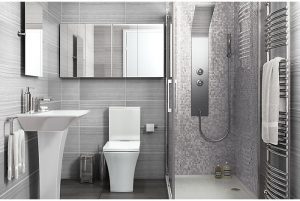While interior design trends are fluid and constantly changing, there are some that are generally resilient in the contemporary marketplace.
Take the increased focus that home-owners are placing on their bathrooms, for example, which has seen the affiliated product markets benefit from increased spending in recent times. In fact, the level of demand for bathroom fixtures increased by more than 12% last year, while it now amounts to a staggering £700 million or more.
Not only this, but it also appears that home-owners are spending more on dark materials with an industrial aesthetic, despite the fact that this flies in the face of traditional logic. In this post, we will explore this trend in closer detail and offer a brief guide of how to use dark colours in a confined bathroom space.

How to Use Dark Colours When Decorating Your Bathroom
Historically, home-owners have been advised to use light and neutral tones when decorating compact spaces such as the bathroom. This is thought to create the illusion of space, and ultimately suit the type of minimalist ethos that most Millennials tend to favour.
This trend has reversed dramatically over the course of the last year, however, as home-owners have looked to utilise dark and atmospheric colours that create a sleek, stylish and streamlined aesthetic. In order to capitalise on this, however, you will need to think carefully about your interior design and consider the following steps:
Use Slate Tiles on Your Walls
Not only are we seeing a rise in the use of dark colours in the bathroom, but there is also a tendency for home-owners to deploy variable shades of the same hew. Grey is a particularly viable choice, as this provides a dark but balanced aesthetic that adds a uniquely contemporary dimension to your design.
So, consider fixing grey slate tiles to your wall and behind your shower unit, while laying a a lighter shade of the same colour to the floor. This will create a subtle contrast between the two shades, breaking up the darkness and creating an exceptionally stylish look in the process.
In terms of the flooring, you can make a selection between tiles and concrete to achieve your desired look. The latter can add a sense of industrial chic to your interior, while these materials are also durable and particularly robust.
Create a Further Contrast By Using Natural Wood and White Fittings
The notion of creating a contrast is important, as this ensures that you can use dark colours in a confined space without making it oppressive. So, as well as using variable shades of grey, you can also integrate natural wood and white fixtures to enlighten your bathroom space and bring it to life.
The use of natural wood is particularly effective, as it helps to optimise any natural light that is allowed into the bathroom during the daytime. This can maximise the sense of space, so consider fitting oak furniture in your bathroom when appraising storage options.
You can also embellish the space with small, subtle and white fittings, such as toothbrush and toilet roll holders. When used sparingly and strategically, this can create a multi-layered space that is truly stunning.
Bring the Outside In and Create a Natural Contrast
On a final note, you may also want to consider bringing the outside in to create a natural contrast for the dark tones that you apply to your bathroom interior. This is part of a wider design trend in the modern age, which has seen home-owners integrate living feature walls in the living and dining rooms.
In terms of the bathroom, you simply need to add one or two potted plants in each corner, as this instantly introduces variable shades of green and alternative textures to the space. By choosing seasonal plants, you can also introduce slightly different colours during alternative times of the year, as well as optimising the level of air flow and quality within the space.
It also helps that green and grey make for a truly striking visual combination, breathing life into your bathroom and ensuring that any darker shades are complimented perfectly.
